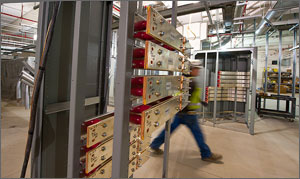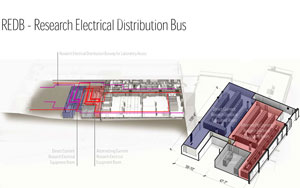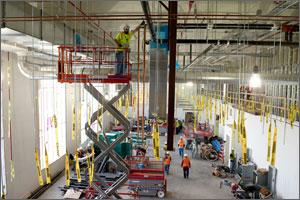NREL's REDB Connects Smart Grid Research
January 27, 2012
 Enlarge image
Enlarge image An electrical contractor walks between two racetrack switchboards, which are being installed in the REDB room of the Energy Systems Integration Facility (ESIF) at NREL. These switchboards are capable of 1,600 amps and are part of the 1 megawatt testing capabilities at ESIF.
Credit: Dennis Schroeder
Credit: Dennis Schroeder
Plug-n-play has become so integrated into daily life that most computer users don't give a second thought to hooking up a camera or smart phone to a laptop or tablet. Now, take the same concept and apply it to the nation's complex electrical systems when it comes to "plugging in" renewables or smart grid technologies.
To make that a reality, the U.S. Department of Energy's (DOE) National Renewable Energy Laboratory (NREL) is building electrically interconnected laboratories as part of its Energy Systems Integration Facility (ESIF) where research partners can literally plug in and test new energy technologies on real and simulated power systems before hooking them up to the grid.
This plug-n-play adaptability is possible because of the Research Electrical Distribution Bus (REDB) at ESIF, which will function as a power integration circuit capable of connecting multiple sources of energy, interconnecting laboratories and experiments. All of this will allow NREL and its partners to test and simulate what happens when components, such as solar inverters, are connected to the grid.
"Each lab in ESIF has its own niche with different kinds of equipment and functionality fostering research on all aspects of energy integration," NREL Electrical Engineer Greg Martin said. "There is nowhere else where you can bring in a piece of equipment, connect it up, and be testing in a matter of days — along with the type of data acquisition we can provide."
Think Big
 Enlarge image
Enlarge image The Research Electrical Distri¬bution Bus (REDB) is the electrical back bone interconnecting many of the laboratories at ESIF. This state-of-the-art facility will enable NREL and industry to work together to develop and evaluate their individual technologies on a controlled integrated energy system platform.
Credit: Rendering courtesy of SmithGroupJJR
Credit: Rendering courtesy of SmithGroupJJR
Made up of four ring buses — two for AC current and two for DC current — the REDB will be the backbone for all of NREL's energy systems integration testing.
"You can think of the ESIF equipped with the REDB as a place where you can bring your equipment and with our real time simulation tools, we can make your equipment think that is connected electrically to another piece of equipment, a utility distribution feeder, or even the grid," Acting Group Manager for Distributed Energy Systems Integration Bill Kramer said.
The scale of the laboratories in the ESIF and the size of the equipment to be tested are hard to visualize, but according to Kramer, a real test scenario for the REDB could include the following.
A research partner delivers an experimental device to ESIF on a flatbed truck. The truck enters the ESIF through large overhead doors that lead into the high bay area of the Power Systems Integration Laboratory where a bridge crane lifts the experiment, which contains a battery in a 40 foot container, off the truck and places it in the lab. The battery is connected to DC power with a programmable switch that is connected to the REDB. Running parallel with the REDB is a Supervisory Control and Data Acquisition (SCADA) system. SCADA enables the researchers safely to turn power on and off, and track the data flowing during the experiment. At this point, using the SCADA and REBD systems, researchers can interconnect that large battery with another laboratory, or to a transformer connected to a solar array in the Outdoor Testing Facility. The battery can be charged and discharged thanks to the ESIF's power hardware in the loop.
SCADA Brings Testing into View
A key element to the testing power systems and components at ESIF is the SCADA, which will serve as the computer control system for the REDB. In addition to controlling the REDB safely, the SCADA also provides high resolution data output. The SCADA will support a large visualization screen in the control room allowing researchers and partners to watch the experiment in real-time.In a control room, researchers can see the electrical bus, close switches, and checkout grid simulators. Research partners will be able to control the systems on portions of the REBD checked out specifically to them. The data from the experiment is streamed to secure servers, so if a utility is working with the lab that information can remain with the researcher and their partner. It's easily compartmentalized so that an experiment has its own power system and data.
Safety is key at NREL and the SCADA will constantly run safety checks to make sure that no equipment is damaged or pushed beyond its safety limits.
ESIF is Not Just for Renewables, or NREL
 Enlarge image
Enlarge image The 5,300 square foot Smart Power Laboratory in ESIF is connected to the REDB. Like most labs in ESIF, the Smart Power Laboratory will be highly configurable and can test anything from home automation technology to advanced inverters.
Credit: Dennis Schroeder
Credit: Dennis Schroeder
"The ESIF labs are reconfigurable so that as technologies advance, we can change with them," Kramer said.
"The design of ESIF in and of itself is an integrated system. ESIF bridges the gap between electrical, thermal, and fuels disciplines."
The nation's utility infrastructure currently is driven by fossil fuels. An objective for ESIF is to make it so industry can use and modify existing pieces of equipment to work with new technologies such as solar and wind.
"We are here to help utilities and companies that want to design new equipment that will increase the penetration of renewables into the energy grid," Kramer said. "However, we won't work just with renewables at the ESIF. We could also test natural gas field generators. This type of testing will also help us move forward because if you don't take into consideration the overall system and only work on a component at a time, you will never come up with the optimal solution."
"At the end of the day, we want to provide a platform to allow other laboratories, government, industry, utilities, to all develop technologies for the future energy marketplace," Martin added. "It is important for everyone to be able to do testing before putting something out in the field and discovering that it didn't work they way they thought. Instead they can bring their equipment to the ESIF, hook it up and it is going to think it is part of the power system."
ESIF also is working to make virtual connections to other laboratories across the country in an effort to share expertise. "If you have a lab, and want to have a virtual connection into the ESIF with your equipment being tested in your lab, you will still be able to make use of ESIF and all of the equipment that is in it," Kramer said.
"We have this amazing capability that no one has ever had before," Martin said. "If you have an idea for novel system, bring it in and we'll test it, or we'll partner with you on some other types of research."
This state-of-the-art facility is scheduled for completion by the end of the year. It will enable NREL and industry to work together to develop and evaluate their individual technologies on a controlled integrated energy system platform. Testing at the ESIF is intended to facilitate widespread adoption of renewable energy and smart grid technologies and help reduce risks associated with early market penetration.
No comments:
Post a Comment
Note: Only a member of this blog may post a comment.